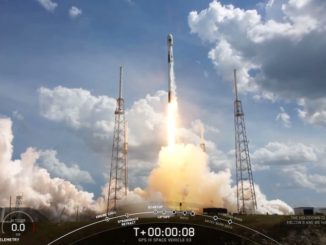
SpaceX chief Elon Musk said last week he is “fairly confident” his company’s Falcon rockets can be made fully reusable within a couple of years, suggesting a renewed emphasis on outfitting upper stages for a scorching re-entry after engineers shelved the idea to focus on landing the launcher’s bigger booster stage.
The launch firm revealed a concept to recover and reuse both stages of the Falcon 9 rocket in 2011, but visible technical progress has been limited to the first stage in the last few years. Landing and relaunching the Falcon 9’s first stage presented a lesser challenge to SpaceX’s engineers, and the booster is the most valuable part of the rocket, representing about 70 percent of its total cost.
SpaceX officials have suggested in the last few years that the company may defer reusing the upper stage for a few years to focus on other projects, or perhaps do away with the idea altogether.
But Musk tweeted Friday that he is “fairly confident we can reuse (the) upper stage, too, by late next year to get to 100%” reusability.
SpaceX is already experimenting with retrieving the Falcon 9 rocket’s payload fairing, a composite structure the protects satellites during the first few minutes of launch through the denser, lower layers of the atmosphere. The fairing splits into two pieces and falls away a few minutes into each flight.
The company succeeded in recovering one-half of the fairing after the last Falcon 9 launch March 30, the same mission that debuted the use of a previously-flown Falcon first stage booster. SpaceX eventually hopes to land the fairing components on a “bouncy” target in the ocean after they come back to Earth with the aid of thrusters and steerable parachutes.
Musk said the fairing costs around $5 million to build, and that part of the rocket should be reusable this year.
An animation of SpaceX’s rocket reuse ambitions released in September 2011 showed both stages of the Falcon 9 rocket coming back to land near the launch site. In the animation, the second stage carries landing legs like the Falcon 9’s booster, using rocket thrust to slow down for re-entry and landing.

But the upper stage must come back to Earth with much higher speed than the first stage because it enters orbit on each mission, meaning it plunges through the atmosphere at a velocity around four times faster than the booster’s initial descent.
The animation shows the upper stage re-entering the atmosphere nose first, protected by a heat shield to keep the rocket’s metallic skin from melting.
SpaceX president and chief operating officer Gwynne Shotwell said at last August’s Conference on Small Satellites at Utah State University that it could take five years to field a reusable upper stage, and Musk tweeted last July that was “really tempting to redesign (the) upper stage for return,” but that it was probably best to focus on the development of a more powerful rocket the company intends to use for human expeditions to Mars.
In a reversal, Musk told reporters after the March 30 launch with SpaceX’s reused booster stage that “it might be fun to try a ‘Hail Mary'” and attempt a landing of the Falcon 9’s upper stage.
Musk identified the maiden flight of the Falcon Heavy rocket, a huge launcher composed of three Falcon 9 first stages bolted together, as a possible candidate to try out landing the upper stage. The Falcon Heavy’s upper stage is much the same as the one flown on the Falcon 9 rocket.
“Odds of success low, but maybe worth a shot,” Musk tweeted March 31.
SpaceX will try to land all three booster stages on the first Falcon Heavy rocket. The two side boosters will return to Cape Canaveral for a vertical landing, and the core stage will target a touchdown on SpaceX’s barge in the Atlantic Ocean.
Another factor that might complicate landing and reusing Falcon rocket upper stages is the recovery system’s potential impact on the launcher’s lift capacity. Outfitting the upper stage for landing, and reserving propellant for descent maneuvers, would result in a “pound for pound” performance penalty because the extra weight would go all the way to orbit with the mission’s payload, Shotwell told the industry magazine Aviation Week and Space Technology in 2014.
The rocket’s performance also takes a hit from the weight of the landing gear and fuel reserve carried on the Falcon 9 first stage for landing, but the impact is not as severe — about 30 to 40 percent — because the booster detaches from the upper stage at a fraction of the speed needed to reach Earth orbit.
Musk touts reusability as a way to dramatically cut the cost of launches, assuming SpaceX can slash the time it takes to prepare a landed rocket for another flight from months to as little as 24 hours.
Shotwell said April 5 that refurbishing the reused Falcon 9’s first stage booster after its first flight in April 2016 cost less than half of the expense of a newly-built rocket stage.
“We did way more to this one than we’re doing on the future ones, of course,” Shotwell said in a speech at the 33rd Space Symposium in Colorado Springs.
For the next few rockets SpaceX aims to refly, Shotwell said engineers will do about a tenth of the work that they did to refurbish the booster that launched March 30 from NASA’s Kennedy Space Center in Florida with the SES 10 communications satellite.
The longer-term objective is to land and refly a first stage booster within 24 hours, with only “brief but important, critical checks and inspections,” Shotwell said.
Email the author.
Follow Stephen Clark on Twitter: @StephenClark1.
Comments will be monitored for language.



